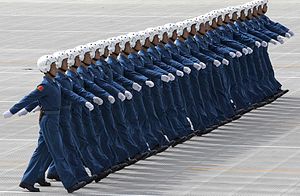An interesting article in the Want China Times considers the rise of China’s military and its capabilities — now and in the future.
The piece notes: “While the People’s Liberation Army continues to acquire more advanced weapon systems, it will still take China at least 30 years to compete with the United States and build the world’s most powerful military force…”
My own opinion: We would need to break this down in terms of looking at the various branches of China’s military across different domains, but who cares! Beijing certainly doesn’t.
OK, some explanation is needed for such a bold assertion.
Modern militaries are designed with certain objectives in mind. While Beijing is clearly focused on a possible challenge by U.S. forces intervening in some sort of future conflict (yes, A2/AD comes into play), China’s armed forces are designed to win, according to most experts, “local wars under informationized conditions.”
Clearly, not every situation under this concept has Beijing’s security professionals worried about American intervention or some sort of plane to plane, ship to ship match-up between the two. And that is exactly how Beijing likes it — for the time being.
Simply put: China does not need to match America symmetrically, only to defend what it defines as its “core interests.” An asymmetric strategy suits Beijing’s aims just fine in this regard.
In looking at some of the domains Chinese forces operate in, not every single one assumes America as the main adversary.
For example, in discussing China’s land forces — in which the article actually references Dennis Blasko, one of the world’s best analysts on China’s land forces — one needs to ask who Beijing would actually be fighting on land these days? Things in Central Asia look quite good for Beijing, with no pressing challenges to consider at the moment. Sino-Russian relations are quite chummy, and there is little to no danger of a fight between these two giants. In fact, China’s lack of concern regarding Russia has allowed it to pour resources into other areas of its armed forces. Beyond peacekeeping forces through the United Nations, China does not seem intent on deploying land forces overseas anytime soon, and clearly not against American forces. It would be a waste of resources to devote vast sums of money to land forces where there is no rival for China to be concerned about in the near-term. Clearly, Beijing is modernizing its land assets, but not at the speed of other areas where it faces much more robust challenges.
This brings us to China’s forces on the high seas — a domain where Beijing has devoted considerable time and energy. Looking at Beijing’s rivals in the South China Sea, if a conflict were to develop between China and pretty much every other major claimant (with the exception of Taiwan), Beijing would defeat its rivals quickly and with relative ease. One of China’s biggest irritants in the South China Sea, the Philippines, has very few maritime assets at its disposal. Its best vessels are ancient U.S. Coast Guard ships, hardly a match for Beijing’s latest destroyers or land-based missiles.
China’s dispute with Japan over the Senkaku/Diaoyu Islands is obviously very different. The Japanese Navy is one of Asia’s best. At the moment, I would give the edge to Japan’s Navy in a one to one matchup with China based on its level of skill, training and sophistication. However, considering the large amounts and growing accuracy of Beijing’s missile forces, and its new class of anti-ship ballistic missiles, nothing could be assumed once the bombs start falling. In time, however, considering Beijing’s growing military budget, focus on 5th generation fighters and increasing naval register, Japan will be hard pressed to hold onto its advantages.
And that brings us naturally to the showdown everyone loves talking about, the much discussed U.S.-China military comparison. While it makes sense for even the most accomplished scholar to try and make direct comparisons of the two nations’ armed forces, the important point is this: Beijing certainly doesn’t.
Chinese military planners have stated time and time again they have no plans to try and match U.S. forces ship for ship, or carrier for carrier. China’s military — at least for the moment — is much more focused on the area around the first island chain, while America’s defense planners are focused on projecting power globally — two very different missions.
This is why understanding China’s much discussed “counter-intervention” strategy or A2/AD is so important. China intends to make things as difficult for America in the event of a conflict as possible. Why bother developing multiple carrier battle groups that would cost billions to build and billions more to maintain? If China can use large amounts of cruise and ballistic missiles, modern conventional submarines, sea-mines and other less costly assets to keep U.S. forces far from areas of contention or do real damage in a fight, that would suit Beijing just fine.
Unfortunately, a simple comparison between militaries is not as easy as the headline writers would have us believe. The true test for a nation’s military is quite simple: can it achieve the goals its leadership lays out and the internal goals it sets for itself? Sadly, that does not lend itself to a sexy headline (although we’ll do our best…); however, this is the question we must ask of China’s military today and going forward.
































